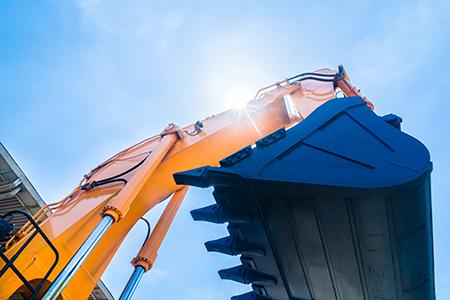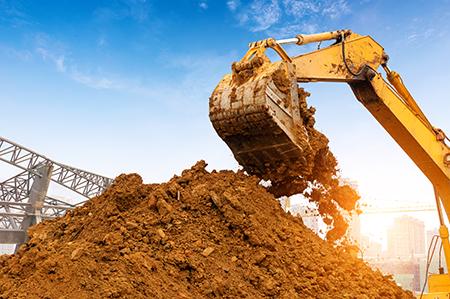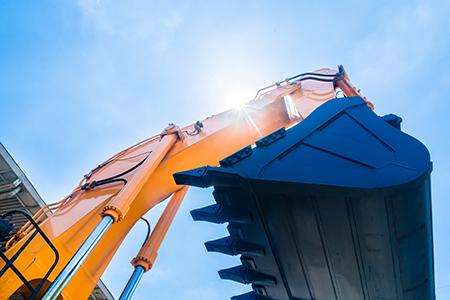If you regularly find yourself in the midst of a construction project, there are certain pieces of equipment which you simply shouldn’t be doing without.
In the event that your site is currently occupied by a dilapidated structure which needs clearing before work can begin on your development, a bulldozer is the perfect solution. When you need to pick up and lift large items, a telehandler should always be on your inventory. If you have large mounds of earth or rubbish to shift, a dumper is just what you need. At the point when you need to smooth out a surface ready to lay a new road, make sure you have a roller to hand.

Telehandlers
A telehandler is a construction vehicle built to lift heavy weights and could be considered the hybrid of a crane and a forklift. The most recognisable feature of a telehandler is its boom, which provides the ability to add attachments to extend the telehandler’s usefulness.
The right choice of attachment and lifting angle on a telehandler can multiply the machine’s maximum lifting weight. Its large arm is similar to the end of a forklift. The arm can extend in order to reach high places and pick up heavy equipment or items.
The boom itself can be used to pick up and carry various items but this versatile machine can do a lot more with its many different attachments which enable the user to carry out a number of tasks. The bucket attachment can accommodate and elevate a person, the fork/table can be used to lift items and the protective safety cage is much like the bucket but on a larger scale.
Operators take advantage of being able to change the angle of the arm. A correctly angled and positioned arm can double or even triple the weight which can be held safely without tipping the machine. Lifting at a high angle without a fully extended arm will usually increase the carrying weight, however, the operator must be fully trained in order to ensure that the machine cannot tip and be destroyed, which will invariably cause injury to the operator.
Dumpers
Dumpers are vehicles used on construction sites in order to haul and dump materials on a building site. Generally, the driver will sit at the back with a container/ skip on the front. The container may be operated manually or powered by electric motors or hydraulics.
A dumper fitted with rubber tracks will offer better traction, especially to those which can lift materials prior to dumping or swivelling. Dumper skips can tip forward so that the contained materials can be dumped onto the ground – hence the name.
Dumpers cannot usually scoop materials; instead, materials will generally be placed in a dumper to be transported before being tipped. The vehicles themselves are usually diesel powered.

Rollers
A road roller is primarily used in the construction of roads. This machine uniformly compresses and levels materials including asphalt, gravel and dirt and comprises a roller body and at least one roller drum. Most road rollers are driven, though there are some rollers which can be pushed by a person to create a level service. The weight of the drum attached to the roller body compresses materials until they are compact.
Drum weight can vary significantly; manual rollers weigh far less than a road roller and will not be used to construct roads, instead they are used to create walkways and within smaller projects. The weight of a road roller comes primarily from the drum and can be increased by adding water to it. Water is heavy but it can be drained when the project is over.
There are lots of different types of road rollers available and each offers something different. Some rollers use a water-based lubricant to stop dirt and asphalt from sticking to the roller’s drum, others have vibration systems which specialise in making materials as compact as possible.
Excavators
An excavator is used to dig or move large objects and made up of two parts; the driving base and the boom arm. When you look at an excavator, the small cab you can see on the driving base is where the driver sits in order to control the arm.
On top of the driving base sits the boom arm and attachment which is designed for digging. The driving base itself features two sets of articulated tracks which are attached to the side and used not only to move the unit but also provide a larger surface area which steadies the unit.
The platform on top of the base can rotate between 180° and 360° and is operated using one of two sets of controls. One set moves the entire unit forwards and backwards whilst the other is intended to move the unit on top of the base and control the arm. This set also controls the angle and speed of the arm movements and the bucket.

Excavators are available in a range of sizes and capacities and the machine is designed for use on construction sites. A license is required to safely operate the machine. When choosing the size of the excavator, you will need to consider the amount of movement required. The heavier the unit, the greater the lift capacity and the greater the capacity for movement, the more flexibility the operator will enjoy.
Bulldozers
The most ominous of earthmoving equipment, a bulldozer is most commonly found on a new construction site. Used for rough deconstruction or as a front-end loader, the front-mounted blade of a bulldozer pushes soil forwards in order to create a level surface for a construction site.
A bulldozer sits on a tracked chassis which keeps it stable on sandy or muddy soil. The machine features a driver cage and a rear mounted ripper claw which efficiently and effectively breaks up:
- Boulders
- Roadway materials
- Pavement
- Hardened ground
The front-mounted blades on a bulldozer push broken up materials forward and the blades themselves are curved for improved cutting power through compacted topsoil.
Anglo Plant Hire Ltd
Plant machinery is a very costly to purchase, particularly if you are not using it on a continuous basis. If you need irregular access to the relevant equipment, it is more than likely more cost-effective for you to hire the machines you need at the time for a fixed period.
Should you wish to discuss your individual needs for machine hire, or you’re not entirely sure which pieces of equipment you might need, why not speak to the team at Anglo Plant Hire Ltd?






